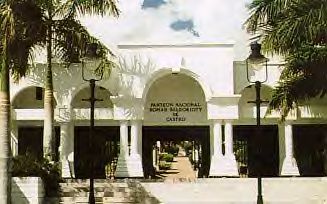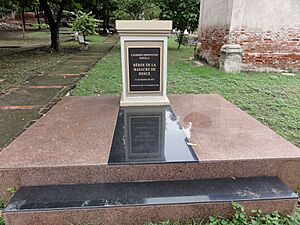Panteón Nacional Román Baldorioty de Castro facts for kids
Quick facts for kids |
|
|
Cementerio Antiguo de Ponce
|
|

The Panteón Nacional Román Baldorioty de Castro, previously known as Cementerio Antiguo de Ponce (looking north)
|
|
| Location | Calle Torre no. 1 and Calle Frontispicio, Ponce, Puerto Rico |
|---|---|
| Area | 3.7 acres (1.5 ha) |
| Built | 1842 |
| Architect | Antonio Torruella (1842) Nieto Blajol Iglesia (1864 project) |
| Architectural style | Neoclassical |
| NRHP reference No. | 84003149 |
| Added to NRHP | 5 January 1984 |
| Lua error in Module:Location_map at line 420: attempt to index field 'wikibase' (a nil value). | |
| Established | 1992 |
|---|---|
| Location | Torres no. 1 &Frontispicio St., Ponce, Puerto Rico |
| Type | Cemetery Museum |
| Visitors | 17,567 (2000) |
| Owner | Autonomous Municipality of Ponce |
The Panteón Nacional Román Baldorioty de Castro is a special place in Ponce, Puerto Rico. It started as the city's main cemetery in 1842. Later, it became a famous burial ground and Puerto Rico's first (and only) national pantheon.
This site is also unique because it's the only cemetery in Puerto Rico and the Caribbean that is also a museum. Before it became a national pantheon, people called it Cementerio Viejo or Cementerio Antiguo de Ponce. It is listed under that old name on the U.S. National Register of Historic Places.
The pantheon is named after Román Baldorioty de Castro. He was a very important Puerto Rican politician. He strongly believed that Puerto Rico should have more control over its own government. His remains are buried here. The pantheon also has a small museum that teaches about the history of self-governance in Puerto Rico. Today, it's used as a park and a place for cultural events. It is also known as the Museo del Autonomismo Puertorriqueño.
The cemetery was built in 1842. Antonio Torruella designed it. It was made bigger in 1864 by Nieto Blajol Iglesia. The cemetery closed for new burials in 1918.
Contents
A Look Back: The Cemetery's History
In 1838, leaders in Ponce decided they needed a new cemetery. The old one was in very bad shape. It was even a danger to public health. The city didn't have enough money to build a new one. So, people in the community offered to help pay.
A group of leaders was chosen to collect money. They also oversaw the building of the new cemetery. The project was approved by the mayor of Ponce in February 1838. However, construction didn't start until 1842. People from the "Villa of Ponce" (the town) made contributions.
In 1843, the cemetery officially opened. Don Juan Rondon Martinez, who was the mayor of Ponce, was the first person buried there. The cemetery was made larger and repaired in 1864. This work included fixing walls and pathways. They also built new burial spots and a small chapel. The cemetery stopped accepting new burials in 1915.
Building Style: Neoclassical Architecture
The cemetery featured small, well-designed mausoleums. These were tombs for important people. They were arranged along a main path. Smaller paths branched off from it. The main path led from the entrance to a chapel at the back.
Most of the buildings were made in the neoclassical style. This style was popular at the time. It uses elements from ancient Greek and Roman buildings. You can see columns and pilasters (flat columns on walls). These often followed Doric, Ionic, or Corinthian designs. The style also included rounded ceilings called barrel vaults. Greek-style triangular tops called pediments and Roman arches were also common.
The strong walls and supports were built using brick and mortar. They also used a mix of crushed brick, sand, stone, and lime. The outer walls were made of brick and mortar. The parts built in 1864 used stone and mortar.
Important People Buried Here
Many famous Puerto Ricans are buried at the Panteón Nacional. They made a big difference in history.
- Román Baldorioty de Castro: He is the most important person buried here. He was a patriot, journalist, teacher, writer, and speaker. He also worked to end slavery. In 1870, he spoke out against slavery in Spain. He helped create many laws that led to freedom. Slavery was officially ended in Puerto Rico in 1873, thanks to his efforts.
- Don Juan Seix: He started the Ponce Fire Department.
- Don Juan Rondon Martinez: He was a mayor of Ponce. He also helped start the cemetery and was the first person buried there.
- Salvador de Vives: Another important mayor. He founded Hacienda Buena Vista, a historic coffee plantation.
- Juan Morel Campos and Manuel G. Tavarez: These were famous composers and musicians. They are known for their danzas, which are traditional Puerto Rican folk music.
- Antonio Paoli: A world-famous singer, known as the "Tenor of Kings."
- Casimiro Berenguer: A hero of the Puerto Rican Nationalist Party.
- The Serrallés Family: Members of this important family are buried here. They founded the Destileria Serralles, a famous rum distillery. The beautiful Castillo Serralles is named after them.
- Roberto Sanchez Vilella: A former governor of Puerto Rico.
- Rafael Cordero Santiago: A late mayor of Ponce. He has a special tomb here.
What the Cemetery Looks Like Now
The cemetery is shaped like a rectangle. It is about 157 meters long and 84 meters wide. There are also a few smaller rectangular areas attached to it.
A small building for preparing bodies (a mortuary) used to be at the entrance. From there, small mausoleums, crypts (underground tombs), and niches (small wall spaces for urns) lined a central path. This path led to a small chapel in the middle of the cemetery. High walls completely surrounded the cemetery, and they are still there today.
Most of the mausoleums and crypts were built in the neo-classical style. They used thick walls and strong supports. These were made from brick, stone, and mortar.
After closing in 1915, the cemetery slowly fell apart. By 1984, it was being damaged by vandals. Tombs were broken into. Much of the cemetery was covered in thick plants. The plaster on the walls had fallen off, leaving the bricks and stones exposed to the weather.
Around 1990, the city of Ponce stepped in to save it. They repaired and rebuilt it. This is when it became the National Pantheon. The architect in charge of the 1991 design was Virgilio Monsanto. The city also opened a small museum about self-governance.
How It's Used Today
The cemetery is not used for burying people who have just passed away. This is because the ground can be unstable. Instead, it is used to move remains after about five years. For example, the remains of Madeleine Velasco Alvarado were moved here in 2008. Rafael Cordero Santiago's remains were moved in 2004.
In April 2014, there was talk about moving the remains of famous singer Cheo Feliciano here. The mayor of Ponce, Maria Melendez, said she would issue an order to move his remains to the Pantheon if possible after one year.
See also
 In Spanish: Panteón nacional Román Baldorioty de Castro para niños
In Spanish: Panteón nacional Román Baldorioty de Castro para niños




